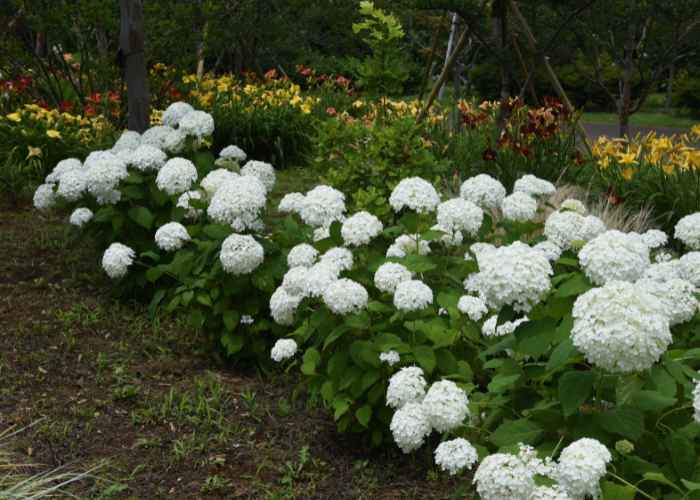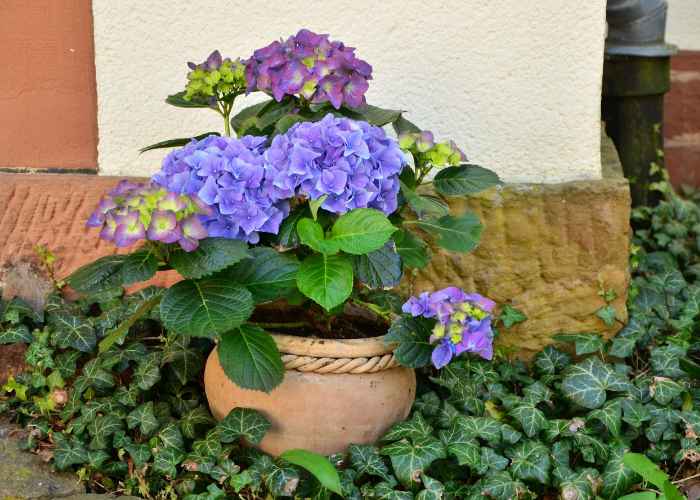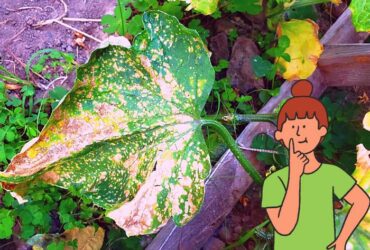Hydrangeas are one of the most popular houseplants, with large flower heads and various colors.
Gardeners and landscapers alike can benefit from the beauty of hydrangea flowers. But they can be tricky to grow, as anyone who has attempted to do so knows.
Don’t worry, in this article, you’ll find valuable tips for growing hydrangeas as a houseplant.
Whether you want to add this ornamental plant to your garden or in a pot inside your home, these tips will be useful.
So, let’s get started!
HOW TO GROW HYDRANGEAS IN A GARDEN?

Hydrangeas love moist soil, so make sure that enough moisture is present in the soil before you plant the hydrangea.
The alternative is to use organic matter that provides moisture to the soil.
Let’s take a look at the step-by-step process of growing them in your garden.
Step 1: Select The Right Location
Choose a location with well-drained soil that receives full or partial sunlight all day. Make sure the location is safe from wild winds.
Step 2: Prepare The Soil For Plantation
Before planting hydrangeas, make sure to prepare the soil using a plant fertilizer. It will add the essential nutrients required by the plant in the initial stage of its growth.
Tip: If your soil is clay-based, make sure to add gypsum and fork it.
Dig a hole of the same depth as the root ball and twice as wide. Remove the plant from the container and place it in the hole. Cut away the tangled roots.
Level the soil the same as the potting mix around the plant.
Water it well to set the soil around the plant.
Step 3: Early Care Tips For Hydrangeas
Make sure the soil is moist as the plant grows. Also, make sure to add organic mulch, and bark chips around the root. This will help keep the soil moist for long.
Step 4: Maintain The Water and Feeding Rate
Hydrangeas usually have larger leaves so they lose water and are prone to drought conditions. It is recommended that you water the plant from spring to autumn to keep its moisture level normal.
You can also apply fertilizer or organic feed once the plant has reached maturity. It will help healthy growth and flower maturation.
There is a fine line between soil quality and pH level, and a simple change in pH can cause the petals to change color. So, test and maintain the pH accordingly.
Step 5: Flowering in Hydrangeas
Growing hydrangeas as a houseplant to cherish its beauty and flowers is wholesome. Most hydrangeas flower during summer and stay alive for a month. It depends on the weather and atmospheric conditions as well.
Now, there are multiple varieties available in the nurseries that bloom flowers for longer. Days after the bloom, flowers change their color and turn brown.
As the flowers are showy, they look very decorative and attractive.
If you are fond of preserving the flowers for longer, cut the stems and place them in cool water in a vase.
Tip: Make sure you don’t cut the stem straight. And change the water on a daily basis to keep the flowers fresh for more days.
Step 6: Pruning
Pruning is an important step in keeping the plant healthy. It helps keep the plant compact and promotes flowering for the next season.
It is recommended to prune the hydrangea during winter. Prune it just above a bump on the stem so that new foliage can be developed during spring.
Remember: Don’t prune Oakland hydrangea during winter because it produces flowers on the stem of the previous season. Prune them right after flowering.
GROWING HYDRANGEAS AS A HOUSEPLANT IN A POT

There are dwarf varieties of hydrangeas that grow up to 75 cm and can be grown in pots. They also make a perfect gift!
Step 1: Select The Right Location
Pick a pot that is at least 30cm wide. Fill it with well-drained soil that receives full or partial sunlight all day. Make sure the location is safe from wild winds.
Step 2: Prepare The Soil For Plantation
Choose a good-quality potting mix and fill the pot partially. Dig a hole of the same depth as the root ball and twice as wide. Remove the plant from the container and place it in the hole. Cut away the tangled roots.
Level the soil the same as the potting mix around the plant.
Water it well to set the soil around the plant.
Step 3: Early Care Tips For Hydrangeas
Make sure the soil is moist as the plant grows. Also, make sure to add organic mulch, and bark chips around the root. This will help keep the soil moist for long.
Step 4: Maintain The Water and Feeding Rate
Hydrangeas usually have larger leaves so they lose water and are prone to drought conditions. It is recommended that you water the plant from spring to autumn to keep its moisture level normal.
You can also apply fertilizer or organic feed once the plant has reached maturity. It will help healthy growth and flower maturation.
There is a fine line between soil quality and pH level, and a simple change in pH can cause the petals to change color. So, test and maintain the pH accordingly.
Step 5: Flowering in Hydrangeas
Growing hydrangeas as a houseplant to cherish its beauty and flowers is a wholesome thing. Hydrangeas flowers bloom during summer and stay alive for a month. It depends on the weather and atmospheric conditions as well.
Now, there are multiple varieties available in the nurseries that bloom flowers for longer. Days after the bloom, flowers change their color and turn brown.
As the flowers are showy, they look very decorative and attractive.
If you are fond of preserving the flowers for longer, cut the stems and place them in cool water in a vase.
Tip: Make sure you don’t cut the stem straight. And change the water on a daily basis to keep the flowers fresh for more days.
Step 6: Pruning
Pruning is an important step in keeping the plant healthy. It helps keep the plant compact and promotes flowering for the next season.
It is recommended to prune the hydrangea during winter. Prune it just above a bump on the stem so that new foliage can be developed during spring.
Remember: Don’t prune Oakland hydrangea during winter because it produces flowers on the stem of the previous season. Prune them right after flowering.
HYDRANGEAS GROWING TIPS
Hydrangea care involves following a few growing tips that are listed below:
- During the growing season, water up to 1 inch around the plant.
- Hydrangeas love to grow in moist soils, so prepare soil accordingly.
- During spring, add organic mulch to the soil.
- Add fertilizer during the growing season of hydrangeas.
- To change the color of the hydrangea flowers, you need to be tricky with changing pH. Raise the pH if you want pink flowers. The best part is hydrangeas grow different colored flowers during the first growing season.
Let’s take a look at the common queries asked by the majority of the gardeners.
PEOPLE ALSO ASK
What Is The Best Hydrangea Season To Grow?
The best time to plant hydrangea is spring or autumn. But if you can maintain moisture levels, you can also plant it during summer.
Are Hydrangeas Poisonous To Dogs?
Hydrangea itself is not poisonous to dogs or other pets. But if your dog chews the plant part, it releases cyanogenic glycoside that is toxic to dogs.
If you love to grow houseplants and have a pet at home, read these 5 Toxic houseplants dog owners should avoid to have a better idea of what plants to avoid.
When Do Hydrangeas Bloom?
Most hydrangeas bloom from late spring to early summer and the blooms stay active until chilly winters.
WRAP UP
The article covers tips for growing hydrangeas in your garden or pots. Hydrangeas are the most common houseplants with large flower heads and various colors.
These moisture-loving plants are easy to grow and take care of.
Follow the steps mentioned above to grow them in your garden or pots. You can also grow them from cuttings.
The flowers bloom from late spring to early summer and remain active until winter.
If you’ve more questions, comment below to ask! Don’t forget to follow for more!














Leave a Reply